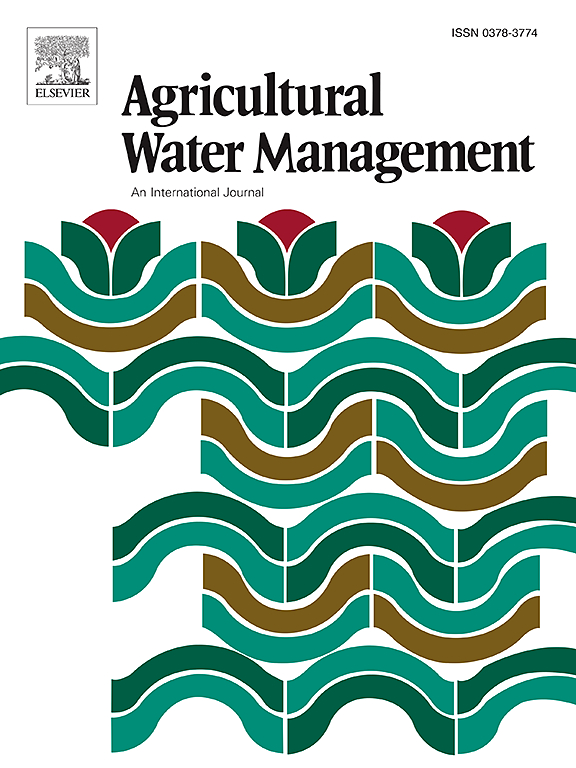干旱区棉田水热生产力与棉花产量对种植方式和种植密度的响应
IF 5.9
1区 农林科学
Q1 AGRONOMY
引用次数: 0
摘要
在中国西部干旱区,种植模式和种植密度对棉花产量形成和资源利用的个别影响已被广泛研究,但其综合影响的研究还很有限。本研究假设优化种植模式和种植密度可提高该地区热液资源生产力和棉花产量。为了验证这一点,在2022-2023年进行了为期两年的田间试验,采用两种主要种植模式(每期4行,每期6行)和三种种植密度(低、中、高)的分畦设计。利用互联网传感器技术对土壤温度和湿度进行监测,评估其时空分布。研究了不同种植模式、密度及其交互作用对棉花产量、产量构成、生物量积累和水分热利用的影响。模式与密度的交互作用显著影响棉花产量、收获指数和水分生产力,种植密度对水分生产力的影响强于种植模式。2023年,低、中密度四行处理的产量高于高密度处理。2年期间,四行低密度处理的水生产力分别比中、高密度处理提高8.77 %和13.40 %,而六行中密度处理的水生产力比低、高密度处理的水生产力分别提高3.64 %和8.74 %。籽棉产量也较高,四行低密度处理比高密度处理分别增产2.88 %和6.15 %,六行中密度处理比高密度处理增产8.51 %和4.79 %。研究进一步分析了土壤水分和温度的时空变化及其与资源生产力和棉花产量的关系。低密度处理与高密度处理的土壤含水量差异在四行模式下为0.10 ~ 0.90 mm,在六行模式下为0.20 ~ 0.70 mm。种植密度对花期和结铃期土壤温度有显著影响。皮棉和种棉产量与土壤产热效率(PEsoil)呈显著正相关,与土壤产水效率(WPc)呈显著负相关,以四行低密度处理和六行中密度处理为最佳。这些发现解释了为什么这些配置导致更高的收获指数和更高的热液资源生产力。该研究为干旱地区棉花产量和资源效率最大化的优化配置提供了有价值的见解,为资源有限条件下的棉花可持续生产提供了支持。本文章由计算机程序翻译,如有差异,请以英文原文为准。
Productivity of water and heat resources and cotton yield response to cropping pattern and planting density in cotton fields in arid area
The individual effects of cropping patterns and planting densities on cotton yield formation and resource utilization have been extensively studied in the arid regions of western China, but research on their combined impacts remains limited. This study hypothesized that optimizing cropping patterns and planting densities would enhance hydrothermal resource productivity and cotton yield in the region. To test this, a two-year field experiment (2022–2023) employed a split-plot design with two main planting patterns (four rows per film and six rows per film) and three planting densities (low, medium, and high) as subplots. Using internet of sensor technology, soil temperature and moisture were monitored to assess their spatial and temporal distributions. The effects of planting pattern, density, and their interactions on cotton yield, yield components, biomass accumulation, and water and heat utilization were evaluated. The interaction between pattern and density significantly influenced cotton yield, harvest index, and water productivity, with planting density exerting a stronger effect on water productivity than planting pattern. In 2023, the four-row pattern at low and medium densities produced higher yields than the high-density treatment. Over the two-year period, the four-row, low-density treatment achieved 8.77 % and 13.40 % greater water productivity than the medium- and high-density treatments, respectively, while the six-row, medium-density treatment outperformed low and high densities, increasing water productivity by 3.64 % and 8.74 %. Seed cotton yield was also higher, with a 2.88 % and 6.15 % increase in the four-row, low-density treatment and an 8.51 % and 4.79 % increase in the six-row, medium-density treatment compared to higher-density treatments. The study further analyzed spatial and temporal variations in soil moisture and temperature and their link to resource productivity and cotton yield. Soil water content differences ranged from 0.10 to 0.90 mm in the four-row pattern and from 0.20 to 0.70 mm in the six-row pattern between low- and high-density treatments. Planting density significantly affected soil temperature during flowering and boll-setting stages. Lint and seed cotton yields showed positive correlations with soil heat production efficiency (PEsoil) and negative correlations with water production efficiency (WPc), with optimal patterns observed in the four-row, low-density and six-row, medium-density treatments. These findings explain why these configurations led to a higher harvest index and enhanced hydrothermal resource productivity. This study provides valuable insights into the optimal configurations for maximizing cotton yield and resource efficiency in arid regions, supporting sustainable cotton production under resource-limited conditions.
求助全文
通过发布文献求助,成功后即可免费获取论文全文。
去求助
来源期刊

Agricultural Water Management
农林科学-农艺学
CiteScore
12.10
自引率
14.90%
发文量
648
审稿时长
4.9 months
期刊介绍:
Agricultural Water Management publishes papers of international significance relating to the science, economics, and policy of agricultural water management. In all cases, manuscripts must address implications and provide insight regarding agricultural water management.
 求助内容:
求助内容: 应助结果提醒方式:
应助结果提醒方式:


